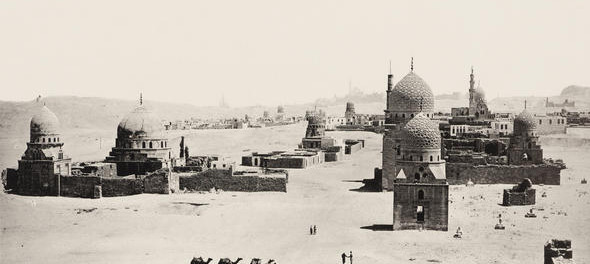Accidental Orientalism. Photographing the 19th Century Arabic City
 Emile Béchard. General View of the Tombs of the Caliphs, Cairo. Plate 16 from portfolio L'Egypte et la Nubie: Grand Album Monumental, HIstorique, Arhictectural. CCA Collection
Emile Béchard. General View of the Tombs of the Caliphs, Cairo. Plate 16 from portfolio L'Egypte et la Nubie: Grand Album Monumental, HIstorique, Arhictectural. CCA Collection
Photographers sometimes catch something unintended in their lens. So too with 19th century European photographers who journeyed to the Arabic world of North Africa and the Middle East. While some went strictly to capture Orientalist types to feed the imaginations of Europeans back home, others caught different sides of Arabic city culture. These images were disseminated in their photos and albums that appeared at world expos in Paris and Chicago. At the same time, the photographers employed fairly new techniques of photographic printing and dissemination with salted prints, albumen prints, lantern slides, and stereocards.
In this well-concevied CCA exhibit, Photographing the Arab City in the 19th Century (currated by curated by Jorge Manuel Simao Alves Correia), 50 photos from the CCA collection are arranged thematically by city components. Starting with gateways, then moving to panoramas, tombs, minarets, street views, and mosques, we see the city both as it was and how the photographer wanted it to be seen. Photographers whose works appear include Francis Frith (UK), Emile Béchard (France), Félix Bonfils (France), and Maxime Du Camp (France). Prussians, Belgians, and others are represented.

Alexander Cavilla, photographer. Street in the old medina of Tangier. 1880s. Albumen silver print, 23.7 x 18.5 cm. CCA Collection. PH1980:0049:001
The CCA exhibit pays special attention to the concepts of the hidden and the overt, expressed as the public (halal) and the private (haram). The street views, for example, rarely show a street for its full length. Instead, photographers capture a linear view of the public street but aim to include the facade of a private home, giving intimacy and personality to a public space. Similarly, in mosques, the photographers try to penetrate the heart of the building, the courtyard. The interior space is a favourite of the photographers, as it allows them the opportunity to capture architectural details in a geometrically designed space.
In both, people are mostly absent from most photographs. They are, by and large, photos of buildings and spaces. In panoramas, the city is always shown as an impenetrable labyrinth. Is this omission a deliberate choice on the part of the photographers or is it simply what was made available to Europeans at the time? Further, is this dichotomy of public and the private more Orientalism in which Europeans impose their pre-conceived view of what the exotic east should look like? Only one photograph captures an actual ritual in action , the Hajj. The 1861 photo is by Egyptian photographer Mohammed Sadic Bey. His photo of a crowd is the first Hajj ever recorded and as an Egyptian, he had access to things forbidden to a wider audience.
The CCA’s exhibit encompasses many major Arabic cities including Cairo and Damascus. It matches well with the current large exhibition How Architects, Experts, Politicians, International Agencies and Citizens Negotiate Modern Planning: Casablanca Chandigarh. Here, Casablanca undergoes urbanization with “help” from other well-meaning nations, yet still tries to maintain its own identity.
Although some CCA exhibits can seem impenetrable, the 19th century Arab one has excellent written text to explain the pieces. With just 8 walls of the octogonal room, it is the right amount of material for a non architectural-historian to enjoy without feeling overwhelmed.
Photographing the Arab City in the 19th Century is at the CCA (1920 Baile) from January 30 – May 25, 2014.







